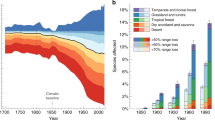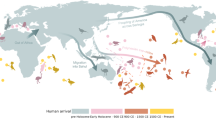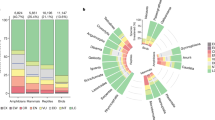Abstract
Greater numbers and higher proportions of recent species extinctions have been on islands rather than on continents. In contrast, predictions of massive future extinctions stem from the current clearing of continental, tropical forests1. For instance, since 1600, 97 out of 108 bird extinctions have been on islands2. However, 452 of the total 1,111 species currently considered to be threatened are continental3. Island flora and fauna are uniquely vulnerable to the human introduction of previously absent predators, diseases and other menaces4, whereas species on continents are not so ecologically naive. So could predictions of future continental extinctions based on island histories be exaggerated1? Most threatened species have small geographic ranges5, and the ranges of island species are inevitably smaller than those of continental species. For a given range size, how do the proportions of threatened island and continental species compare? Here we compile the ranges of thepasserine (perching) birds of the Americas. Corrected for range size, continental species are more—not less—likely to be threatened. We use this unexpected vulnerability of continental species with small ranges to produce a map showing where species losses might occur in the long term.
This is a preview of subscription content, access via your institution
Access options
Subscribe to this journal
Receive 51 print issues and online access
$199.00 per year
only $3.90 per issue
Buy this article
- Purchase on Springer Link
- Instant access to full article PDF
Prices may be subject to local taxes which are calculated during checkout


Similar content being viewed by others
References
Pimm, S. L. et al. The future of biodiversity. Science 269 , 347–350 (1995).
Johnson, T. H. & Stattersfield, A. J. Aglobal review of island endemic birds. Ibis 132, 167– 180 (1990).
Collar, N. J., Crosby, M. J. & Stattersfield, A. J. Birds to Watch 2 (Smithsonian Institution Press, Washington, D.C., (1994).
Pimm, S. L. The Balance of Nature? (University of Chicago Press, Chicago, ( 1991).
Stattersfield, A. J. et al. Endemic Bird Areas of the World (Smithsonian Institution Press, Washington, DC, (1998).
Milberg, P. & Tyrberg, T. Naı ¨ve birds and noble savages—a review of man-caused prehistoric extinctions of island birds. Ecography 16, 229–250 (1993).
Pimm, S. L., Moulton, M. P. & Justice, L. J. in Extinction Rates (eds Lawton, J. H. & May, R.) 75–87 (Oxford University Press, New York, (1995).
Goode's World Atlas18th edn (ed. Espenshade E. Jr) (Rand McNally, Chicago, (1990).
Lack, D. Island Biology Illustrated by the Land Birds of Jamaica (Blackwell, London, (1976).
Castro, I. & Phillips, A. A Guide to the Birds of the Galapagos Islands (Princeton University Press, Princeton, (1996 ).
Stotz, D. F. et al. Neotropical Birds, Ecology and Conservation (Univ. of Chicago Press, Chicago, (1996).
MacArthur, R. H., Diamond, J. M. & Karr, J. Density compensation in island faunas. Ecology 53, 330–342 ( 1972).
Green, R. E. & Hirons, G. J. M. in Bird Population Studies (eds Perrins, C., Lebreton, J.-D. & Hirons, G.) 683 (Oxford University Press, Oxford, (1991).
Gaston, K. J., Blackburn, T. M. & Lawton, J. H. Interspecific abundance-range size relationships: an appraisal of mechanisms. J. Anim. Ecol. 66, 579–601 (1997).
Collar, N. J., Wedge, D. C. & Long, A. J. in Ornithological Monographs, 48, Studies in Neotropical Ornithology Honoring Ted Parker (ed. Remsen, J. V. J.) 237– 260 (American Ornithologists Union, Winfield, KS, ( 1997).
Brooks, T. M. & Balmford, A. Atlantic forest extinctions. Nature 380, 115 (1996).
Bucher, E. & Nores, M. in ICBP Technical Publications, 7, Ecology and Conservation of Grassland Birds (ed. Goirup, P.) 71 –79 (Cambridge University Press, Cambridge, ( 1998).
Ridgely, R. S. & Tudor, G. The Birds of South America Vol. 1 (Univ. of Texas, Austin, TX, (1989).
Ridgely, R. S. & Tudor, G. The Birds of South America Vol. 2 (Univ. of Texas, Austin, TX, (1994).
Raffaele, H. et al. A Guide to the Birds of the West Indies (Princeton University Press, Princeton, NJ, (1998).
Howell, S. N. G. & Webb, S. A Guide to the Birds of Mexico and Northern Central America (Oxford University Press, New York, (1995).
Stiles, F. G., Skutch, A. F. & Gardner, D. A Guide to the Birds of Costa Rica (Cornell University Press, Ithaca, (1989).
Godfrey, W. E. The Birds of Canada (National Museum of Canada, Ottawa, ( 1986).
Price, J., Droege, S. & Price, A. The Summer Atlas of North American Birds (Academic, New York, (1995).
Ridgely, R. S. & Gwynne, J. A. A Guide to the Birds of Panama (Princeton University Press, Princeton, ( 1989).
Sibley, C. G. & Monroe, B. L. J. Distribution and Taxonomy of Birds of the World (Yale University Press, New Haven, ( 1990).
Sibley, C. G. & Monroe, B. L. J. A Supplement to Distribution and Taxonomy of Birds of the World (Yale University Press, New Haven, (1993).
Acknowledgements
We thank C. G. Anderson, K. Balent, N. Collar, J. Gittleman, R. Green, A. Mayer, M.P. Nott, B. Powell, G. Russell, W. Simms, J. Smith, A. Stattersfield and C. Wilder. This work was supported by a fellowship to S.L.P. from the Pew Foundation for Conservation and the Environment and by the Center for Conservation, Stanford University.
Author information
Authors and Affiliations
Corresponding author
Rights and permissions
About this article
Cite this article
Manne, L., Brooks, T. & Pimm, S. Relative risk of extinction of passerine birds on continents and islands . Nature 399, 258–261 (1999). https://doi.org/10.1038/20436
Received:
Accepted:
Issue Date:
DOI: https://doi.org/10.1038/20436
This article is cited by
-
Power laws in species’ biotic interaction networks can be inferred from co-occurrence data
Nature Ecology & Evolution (2023)
-
Small brains predisposed Late Quaternary mammals to extinction
Scientific Reports (2022)
-
Factors Associated with Listing Decisions under the U.S. Endangered Species Act
Environmental Management (2021)
-
Linking the seven forms of rarity to extinction threats and risk factors: an assessment of North American fireflies
Biodiversity and Conservation (2020)
-
Combining genetic structure and demographic analyses to estimate persistence in endangered Key deer (Odocoileus virginianus clavium)
Conservation Genetics (2017)
Comments
By submitting a comment you agree to abide by our Terms and Community Guidelines. If you find something abusive or that does not comply with our terms or guidelines please flag it as inappropriate.



